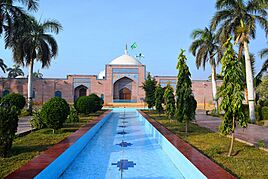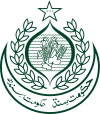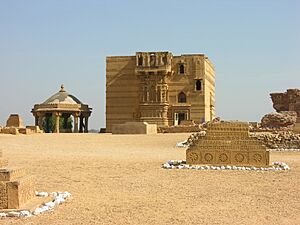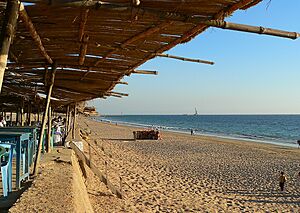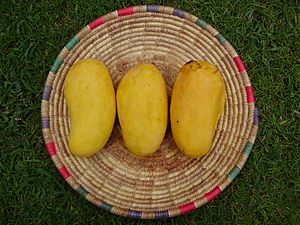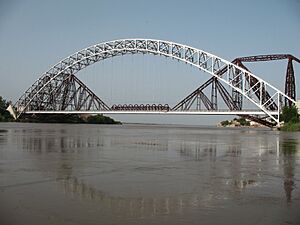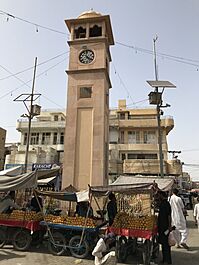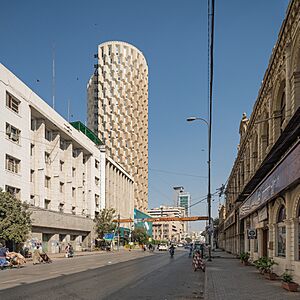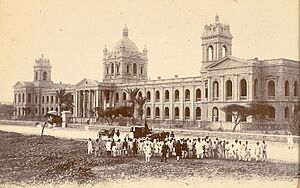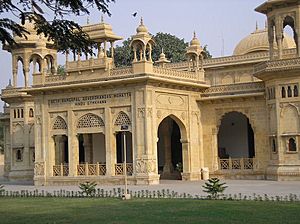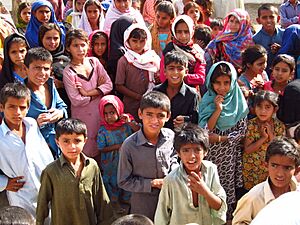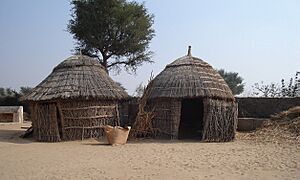Sindh facts for kids
Quick facts for kids
Sindh
|
|||
|---|---|---|---|
| Province of Sindh | |||
|
|
|||
|
|||
| Nickname(s):
Mehran (Gateway), Bab-ul-Islam (Gateway of Islam)
|
|||
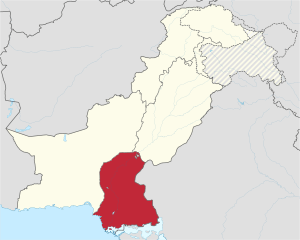
Location of Sindh in Pakistan
|
|||
| Country | |||
| Established | 1 July 1970 | ||
| Before was | Part of West Pakistan | ||
| Capital and largest city |
Karachi | ||
| Government | |||
| • Type | Self-governing province subject to the federal government | ||
| • Body | Government of Sindh | ||
| Area | |||
| • Total | 140,914 km2 (54,407 sq mi) | ||
| Area rank | 3rd | ||
| Population
(2023 census)
|
|||
| • Total | 55,696,147 | ||
| • Rank | 2nd | ||
| • Density | 395/km2 (1,020/sq mi) | ||
| Demonym(s) | Sindhi | ||
| GDP (nominal) | |||
| • Total | $86 billion (2nd) | ||
| • Per Capita | $1,997 (3rd) | ||
| GDP (PPP) | |||
| • Total | $345 billion (2nd) | ||
| • Per Capita | $7,209 (3rd) | ||
| Time zone | UTC+05:00 (PKT) | ||
| ISO 3166 code | PK-SD | ||
| Languages | |||
| Notable sports teams | Sindh cricket team Karachi Kings Karachi United Hyderabad Hawks Karachi Dolphins Karachi Zebras |
||
| HDI (2021) | 0.517 Low |
||
| Literacy rate (2020) | 61.8% | ||
| Seats in National Assembly | 75 | ||
| Seats in Provincial Assembly | 168 | ||
| Divisions | 6 | ||
| Districts | 30 | ||
| Tehsils | 138 | ||
| Union Councils | 1108 | ||
| Website | sindh.gov.pk | ||
Sindh is a province in Pakistan. It is in the southeastern part of the country. Sindh is the third largest province by land area. It is also the second largest by population, after Punjab.
Sindh shares borders with Balochistan to the west and north-west. It borders Punjab to the north. To the east, it has an international border with the Indian states of Gujarat and Rajasthan. The Arabian Sea is to the south.
The land in Sindh is mostly flat plains near the Indus River. There is also the Thar Desert of Sindh in the east. The Kirthar Mountains are in the western part of the province.
Sindh's economy is the second largest in Pakistan. Its capital, Karachi, is the biggest city in the country. Karachi is also Pakistan's main financial center. Sindh has a big part of Pakistan's industries. It also has two busy seaports: Port Qasim and the Port of Karachi. The rest of Sindh's economy is based on farming. It grows fruits, vegetables, and other goods for the country.
Sindh is sometimes called Bab-ul Islam, which means 'Gateway of Islam'. This is because it was one of the first places in the Indian subcontinent to come under Islamic rule. The province is known for its special culture. This culture is greatly shaped by Sufist Islam. Sufism is important for both Hindus and Muslims in Sindh.
Sindh is also famous for its history from the Bronze Age. This was when the Indus Valley civilization existed. Sindh is home to two UNESCO World Heritage Sites: the Makli Necropolis and Mohenjo-daro.
Contents
What's in a Name?
The word Sindh comes from the Sanskrit word Sindhu. This means "river," and it refers to the Indus River.
When the Greeks came to Sindh in 325 BCE with Alexander the Great, they called the Indus River Indós. This is where the modern name Indus comes from. Ancient Iranians called everything east of the Indus River hind.
Some people think the name Sindhu might come from Cintu. This is a Dravidian word for date palm, a tree common in Sindh.
The old spelling Sind was changed to Sindh in 1988.
A Look Back in Time: Sindh's History
Ancient Times and Early Civilizations
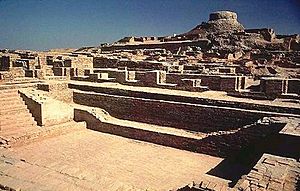
Sindh has the ruins of the ancient Indus Valley Civilization. One famous example is Mohenjo-daro. This city was built around 2500 BCE. It was one of the largest cities of its time. Mohenjo-daro had planned streets, standard bricks, and covered sewer systems. It was one of the world's first major cities. It existed at the same time as ancient Egypt and Mesopotamia.
Mohenjo-daro was left empty around 1900 BCE. This was when the Indus Valley Civilization started to decline. The city was not found again until the 1920s. It became a UNESCO World Heritage Site in 1980. Today, the site faces threats from erosion.
During the Bronze Age, Sindh was known as Sindhu-Sauvīra. This area covered the lower Indus River Valley. Its capital was Roruka, which is now Rohri.
Later, the Achaemenids (Persians) took over the region. They called it Hindush. After them, Alexander the Great conquered parts of Sindh. He appointed a governor and built a harbor at Patala.
Then, Chandragupta Maurya took control of the area. After about 100 years of Mauryan rule, the region was ruled by the Indo-Greeks. Then came the Indo Scythians. Later, Sasanian rulers from Persia also claimed control.
Local rulers, the Rai dynasty, ruled Sindh for 144 years. Their capital was Aror. The Brahmin dynasty of Sindh followed them. Much of what we know about them comes from the Chach Nama book.
Medieval Era and Islamic Rule
In 712 CE, Mohammed Bin Qasim defeated the Brahmin dynasty. He made Sindh part of the Umayyad Caliphate. This was the start of Islam in the Indian subcontinent.
The Habbari dynasty then ruled much of Sindh from 854 to 1024. They were semi-independent but still loyal to the Abbasid Caliphate. Sultan Mahmud Ghaznavi defeated the Habbaris in 1026. He then added Sindh to the Ghaznavid Empire. This ended Arab rule in Sindh.
The Soomra dynasty was a local Sindhi Muslim group that ruled from the early 11th to the 14th century. They became powerful after the Habbarids fell.
The Sammas took over from the Soomras around 1335. They created the Sindh Sultanate. They were independent for a while. The Sammas made important contributions to architecture. The Makli Necropolis in Thatta is a huge burial site with their royal tombs. It covers 10 square kilometers. The Turkic Arghuns later overthrew the Sammas in the late 15th century.
Modern Times and British Rule
In the late 16th century, Akbar brought Sindh into the Mughal Empire. Mughal rule lasted until the early 18th century in lower Sindh. Upper Sindh was ruled by the local Kalhora dynasty. They moved their capital to Hyderabad in 1768.
The Talpurs took over from the Kalhoras. They were Baloch and ruled from 1783 until 1843. The British defeated them at the Battle of Miani and Battle of Dubbo.
The northern branch of the Talpur dynasty, the princely state of Khairpur, kept some independence under British rule. Its ruler joined the new Dominion of Pakistan in 1947.
British Control and Calls for Change
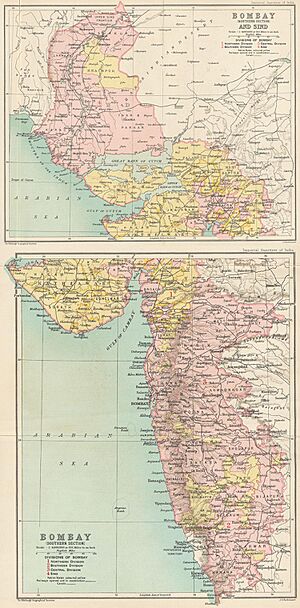
The British conquered Sindh in 1843. Their goals were to strengthen their rule and use Sindh for trade. They wanted Sindh to be a market for British goods and a source of raw materials.
The British made Sindh part of the Bombay Presidency. People in Sindh felt ignored because Bombay was far away. There were talks about joining Sindh with Punjab, but this was rejected. Both Muslims and Hindus in Sindh did not want to be part of Punjab.
Later, people in Sindh wanted their own separate government. In 1913, a Sindhi Hindu asked for Sindh to be separated from Bombay. He said Sindh had its own unique culture. This was also because Hindu business people in Sindh wanted to compete less with those in Bombay.
In the 1920s, Karachi became more important. The Khilafat Movement also grew. This movement supported the Ottoman Caliphate. Many Sindhi pirs (descendants of Sufi saints) joined this movement. They helped gather a lot of support for the Khilafat cause in Sindh.
Sindh had a good history of people from different religions living together. But the Muslim leaders and middle class wanted Sindh to be separate from Bombay. They believed this would protect their own interests. They saw Sindhi Hindus as representing Bombay's interests, not those of Sindhi Muslims.
In Sindh's first election after it separated from Bombay in 1936, economic issues were important. Over time, British policies led to more land in Sindh being owned by Hindus instead of Muslims. Religious tensions also grew over the Sukkur Manzilgah issue. This was about an old mosque near a Hindu holy site. The Sindh Muslim League fought for the mosque to be returned to Muslims.
Sindhi Muslim nationalists supported the Pakistan Movement. They saw the creation of Pakistan as a way to improve their lives. Most Sindhi Muslims strongly supported Pakistan. They hoped it would help their businesses compete better with Hindu businesses. The Muslim League gained strong support in Sindh by getting help from local religious families.
The Partition of India (1947)
In 1947, the division of India into India and Pakistan did not cause much violence in Sindh. This was different from Punjab. There were few violent events in Sindh. This was partly because of Sindh's Sufi culture, which teaches religious tolerance. Also, Sindh was not divided. It became part of Pakistan completely.
Sindhi Hindus who left usually did so out of fear, not because they were being attacked. They were worried about Muslim refugees arriving from India. Many Sindhi Hindus traveled to India by sea.
People of Sindh
Population and Development
Sindh has the second highest Human Development Index among Pakistan's provinces. This index measures how well people live. The 2023 Census showed Sindh's population was about 55.7 million people.
Religions in Sindh
![]()
![]()
![]() Islam has a long history in Sindh. It began when Muhammad Bin Qasim captured Sindh in 712 CE. Over time, most people in Sindh became Muslim, especially in rural areas. Today, Muslims make up 90% of the population.
Islam has a long history in Sindh. It began when Muhammad Bin Qasim captured Sindh in 712 CE. Over time, most people in Sindh became Muslim, especially in rural areas. Today, Muslims make up 90% of the population.
Islam in Sindh has a strong Sufi tradition. Many Sufi saints and mystics, like the poet Shah Abdul Latif Bhittai, lived here. A popular story says that 125,000 Sufi saints are buried on Makli Hill near Thatta. Sufism is still very important in the daily lives of Sindhis.
Sindh also has the highest percentage of Hindus in Pakistan. They make up about 8.8% of the population. This is about 4.9 million people. The Shri Ramapir Temple in Tandoallahyar is in Sindh. Its yearly festival is the second largest Hindu pilgrimage in Pakistan. Sindh is the only province in Pakistan with a special law for Hindu marriages.
There are also about 10,000 Sikhs in Sindh.
Languages Spoken in Sindh
According to the 2023 census, the main language spoken in Sindh is Sindhi. About 60.14% of the people speak it as their first language.
Other languages spoken include:
Karachi is the most diverse city in Sindh. It has most of the province's Urdu-speaking people, along with many other groups.
Geography and Nature
Sindh is in the western part of South Asia. It borders the Iranian plateau to the west. It is the third largest province in Pakistan by area. Sindh stretches about 579 kilometers from north to south. Its area is about 140,915 square kilometers.
Sindh is bordered by the Thar Desert to the east. The Kirthar Mountains are to the west. The Arabian Sea and Rann of Kutch are to the south. In the middle of Sindh is a fertile plain along the Indus River.
Sindh has three main geographical areas:
- Siro (Upper Sindh), which is above Sehwan.
- Vicholo (Middle Sindh), from Sehwan to Hyderabad.
- Lāṟu (Lower Sindh), which is mostly the Indus Delta below Hyderabad.
Plants of Sindh
The province is mostly dry. There is not much plant life except in the irrigated Indus Valley. In the western hills, you can find dwarf palm, Acacia Rupestris (kher), and Tecomella undulata (lohirro) trees.
In the Indus valley, the Acacia nilotica (babul) is very common. It grows in thick forests along the Indus River banks. Other common trees include Azadirachta indica (neem), Zizyphys vulgaris (ber), Tamarix orientalis (jujuba lai), and Capparis aphylla (kirir).
Mango, date palms, banana, guava, orange, and chiku are common fruit trees. Along the coast, there are semi-aquatic plants. The Indus delta islands have forests of Avicennia tomentosa (timmer) and Ceriops candolleana (chaunir) trees. Water lilies grow in many lakes and ponds, especially in lower Sindh.
Animals of Sindh
In the western rocky mountains, you can find the Sindh ibex (sareh), blackbuck, wild sheep (Urial or gadh), and wild bear. The leopard is now rare, and the Asiatic cheetah is gone. The Pirrang (a large tiger cat) in the eastern desert is also disappearing.
Deer live in the lower rocky plains and eastern regions. So do the Striped hyena (charakh), jackal, fox, porcupine, common gray mongoose, and hedgehog. The Sindhi phekari, also known as the red lynx or Caracal cat, is found in some areas.
Crocodiles are rare. They only live in the calm waters of the Indus, the eastern Nara channel, and Karachi backwaters. Besides many kinds of marine fish, plumbeous dolphins, beaked dolphins, blue whales, and skates are found along the Sindh coast. The Pallo (Sable fish), a sea fish, swims up the Indus every year to lay eggs.
The Indus river dolphin is one of the most endangered animals in Pakistan. It lives in the northern part of the Indus river in Sindh. Hog deer and wild bear are found in the central flood areas.
Even though Sindh has a dry climate, its forests, lakes, mountains, and deserts support many different animals. The national parks in Sindh protect a wide variety of animals and birds. The Kirthar National Park covers over 3,000 square kilometers of desert, forests, and a lake. It is home to the Sindh ibex, wild sheep (urial), and black bear. Rare leopards are also sometimes seen.
Between July and November, giant olive ridley turtles lay their eggs along the coast. These turtles are protected. Officials collect the eggs and protect them until they hatch to keep them safe from predators.
Sindh's Climate
Sindh is in a warm region. It is hot in summer and mild to warm in winter. Temperatures often go above 46°C (115°F) between May and August. The lowest average temperature is 2°C (36°F) in December and January in the northern, higher areas.
The average rainfall is about seven inches per year. Most of this rain falls in July and August. The southwest monsoon winds blow from mid-February to the end of September. Cool northerly winds blow from October to January.
Sindh is between two monsoons. It avoids the full force of both. The lack of rain is made up for by the Indus River. The river floods twice a year. This happens when snow in the Himalayas melts in spring and summer, and from monsoon rains.
Sindh has three climate zones:
- Siro (the upper region, around Jacobabad): The air is usually very dry here.
- Wicholo (the middle region, around Hyderabad): Temperatures are generally lower than in Siro but higher than in Lar. Summers have dry hot days and cool nights. Maximum temperatures reach about 43-44°C (109-111°F).
- Lar (the lower region, around Karachi): This area has a more humid climate. It is affected by winds from the southwest in summer and northeast in winter. It gets less rainfall than Central Sindh. Maximum temperatures reach about 35-38°C (95-100°F).
In the Kirthar range, at places like Gorakh Hill, temperatures can get close to freezing. Sometimes, there is even a brief snowfall in winter.
Major Cities in Sindh
| List of major cities in Sindh | ||||
|---|---|---|---|---|
| Rank | City | District(s) | Population | Image |
| 1 | Karachi | Nazimabad, Orangi, Gulshan, Korangi, Malir, Keamari, Karachi | 21,910,352 | 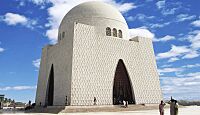 |
| 2 | Hyderabad | Hyderabad | 1,732,693 | 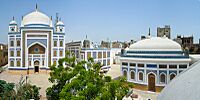 |
| 3 | Sukkur | Sukkur | 499,900 |  |
| 4 | Larkana | Larkana | 490,508 |  |
| 5 | Benazirabad | Shaheed Benazirabad | 279,689 | 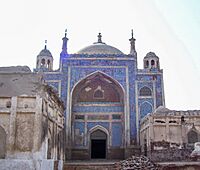 |
| 6 | Kotri | Jamshoro | 259,358 | 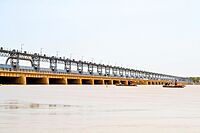 |
| 7 | Mirpur Khas | Mirpur Khas | 233,916 | 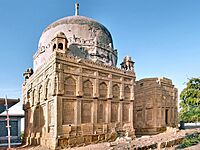 |
| 8 | Shikarpur | Shikarpur | 195,437 | |
| 9 | Jacobabad | Jacobabad | 191,076 |  |
| 10 | Khairpur | Khairpur | 183,181 | 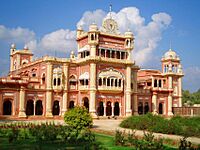 |
| Source: Pakistan Census 2017 | ||||
| This is a list of city proper populations and does not indicate metro populations. | ||||
Economy of Sindh
Sindh's economy is very important to Pakistan. Its capital, Karachi, is a major financial and industrial center. The province has two of Pakistan's busiest seaports, Port Qasim and the Port of Karachi. These ports help with trade and shipping.
Beyond the cities, much of Sindh's economy is based on farming. Farmers in Sindh grow fruits, vegetables, and other goods. These products are then sent to other parts of the country.
Education in Sindh
Education is very important in Sindh. The literacy rate, which is the percentage of people who can read and write, has been increasing. In 2017, it was 54.57%.
Sindh has many public and private schools, colleges, and universities. These institutions offer different levels of education, from primary school to advanced degrees.
Some major educational institutes in Sindh include:
- Aga Khan University
- Bahria University
- D. J. Science College
- Dow University of Health Sciences
- Hamdard University
- Institute of Business Administration, Karachi
- Liaquat University of Medical & Health Sciences
- Mehran University of Engineering and Technology
- National Academy of Performing Arts
- NED University of Engineering and Technology
- Shah Abdul Latif Bhitai University
- Sindh Agriculture University
- University of Karachi
- University of Sindh
Culture of Sindh
Sindh has a very rich culture. Its art, history, and architecture are fascinating. The culture, folk tales, art, and music of Sindh tell a long story of human history.
Artistic Traditions and Craftsmanship
Sindhi artisans were famous for their work. Their crafts were sold in ancient markets in cities like Damascus and Baghdad. An English traveler in the 1800s, T. Posten, said that the lacquer work from Hala in Sindh was as good as fine Chinese art.
Over time, new tools like the spinning wheel (charkha) and treadle were added to weaving. The ways of designing, dyeing, and printing fabrics also improved. The light, colorful, and washable fabrics from Hala became very popular.
Today, groups like the World Wildlife Fund, Pakistan, help promote Sindhi culture. They train women artisans in Sindh to help them earn money. They sell these products under the name "Crafts Forever." Many women in rural Sindh are skilled at making traditional caps. These Sindhi caps are sold in places like New Saeedabad and Hala New.
People in Sindh celebrate Sindhi Topi Day on December 6th each year. On this day, they wear the traditional Ajrak shawl and Sindhi topi (cap) to honor their culture.
Tourism in Sindh
Sindh offers many interesting places to visit. From ancient ruins to beautiful natural sites, there's a lot to explore.
- Mohenjo-daro: This is an ancient city from the Indus Valley Civilization. It's a UNESCO World Heritage Site.
- Makli Necropolis: Located near Thatta, this is one of the largest burial sites in the world. It has many historical tombs.
- Ranikot Fort: Known as one of the largest forts in the world, it's a massive structure in Jamshoro.
- Kirthar National Park: This park offers a chance to see wildlife like the Sindh ibex and wild sheep.
- Gorakh Hill Station: A hill station in Dadu, offering cooler temperatures and scenic views.
- Shah Jahan Mosque, Thatta: A beautiful historic mosque with unique architecture.
- Keenjhar Lake: A large freshwater lake, popular for picnics and boating.
- Lal Shahbaz Qalandar Shrine: A famous Sufi shrine in Sehwan Sharif.
- Karachi: The capital city, with attractions like Mazar-e-Quaid, Clifton Beach, and the National Museum of Pakistan.
- Sukkur: Home to the historic Sukkur Bridge and the Ayub Bridge.
- Faiz Mahal: A beautiful palace in Khairpur.
- Chaukhandi tombs: Unique ancient tombs near Karachi.
- Nagarparkar Jain Temples: Remains of 9th-century Jain temples in the Thar Desert.
See also
 In Spanish: Sind para niños
In Spanish: Sind para niños







